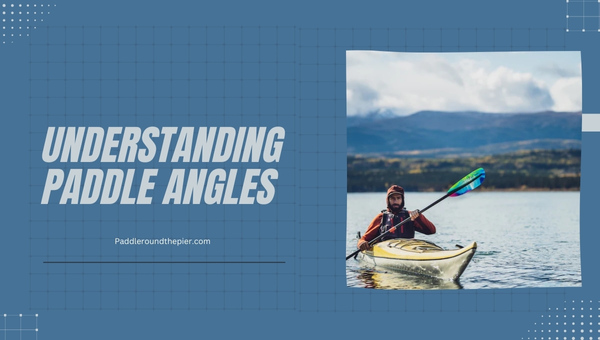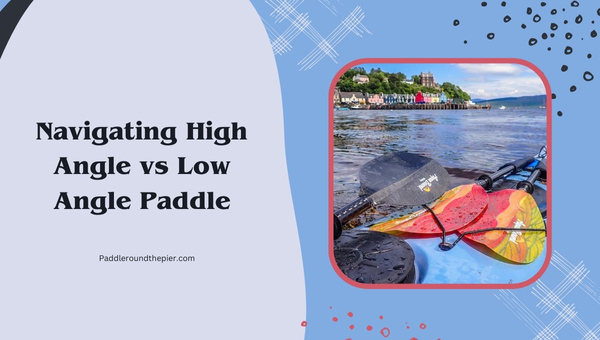High Angle vs Low Angle Paddle: A Detailed Comparison
When it comes to paddling, there's no one-size-fits-all approach. Different situations call for other techniques. Are you intrigued yet? We're about to delve into the world of High Angle vs Low Angle Paddle, a detailed comparison, breaking down their concepts, benefits, drawbacks, transition possibilities, and key equipment so you can make an informed choice. Because in paddle sports, precision is everything.
The perfect balance between high-angle paddling & low-angle paddling relies on various factors - from your personal comfort preference to the kind of kayaking journey you are embarking upon.
High-angle paddles are designed for power and agility with every stroke, making them ideal when speed is a priority. Low-angle paddles have longer shafts that enable a more relaxed style suited for long-distance touring or calm flat water.
What You'll Gain From This Dish:
- An in-depth understanding of high-angle and low-angle paddle techniques.
- Insightful tips to pick the ideal situation-specific paddle method.
- Striking the balance between comfort and efficiency during your kayaking endeavors.
- Wise allocation of energy via proper technique selection for any padding journey.
Understanding Paddle Angles
The world of kayaking, with its unique paddle techniques and precise maneuvers, is fascinating to both beginners and advanced paddlers alike. Out on the water, one area unknown to many but important for all involves navigating the dance between high-angle paddling & low-angle paddling.

The Concept of High Angle Paddling
High-angle paddling is a kayak paddle style that turns up the speed and control, offering an enviable level of maneuverability once perfected. If you’ve ever watched seasoned kayakers deftly gliding across choppy waves, chances are they were using high-angle techniques.
Unlike casual stroking where the paddle lightly skims a friendly surface, high-angle paddling demands more. Held at an acute degree relative to the water surface (almost vertical), you immerse more of your blade into the water with each stroke.
Your hand placement here will be close to shoulder height or at least above your heart if sitting. Quickness defines high-angle strokes – shallow yet powerful strikes that enable:
- Quick changes in direction
- Faster acceleration
- Greater control over the kayak’s path
- Refined technique for whitewater rapids or rescue scenarios
With this technique comes an added need for effective stamina management as well as choosing the right paddle geared towards high-angle efficiency.
Insights into Low-Angle Paddling
Shifting focus now to low-angle paddling reveals a different narrative of endurance-based kayaking tactics. This style sees your paddle held at a slash-like position relative to the water’s surface; imagine having it similar to when biking uphill - low but firm.
While initially less agile compared to its spirited counterpart - high-angle stroking, this refined form excels at:
- Sustained periods on water, even over long distances
- Conserving energy during calm cruises
- Maintaining streamlined forward movement
Low-angle strokes are commonly characterized by their longer, smoother pull that gracefully wades through water. Subtle yet strong, going the low-angle route also necessitates the ability to choose a fitting paddle that bolsters this technique’s effectiveness.
Also Read: Uncover The Beach Wagon: Guide to Coastal Comfort & Pleasure
Benefits And Drawbacks
Diving into paddle precision, it's worthwhile to scout out the upsides and pitfalls of both high-angle paddling and low-angle paddling.
These two paddle styles have their unique advantages that appeal to various kayak enthusiasts; however, they also come with a few downsides that might sway you one way or the other.
Advantages of High Angle Paddling
High-angle paddling is a favorite among many kayakers, and for good reasons:
- Speed: With high-angle paddling, each stroke dives deeper into the water allowing for more aggressive and faster propulsion.
- Control: The power of high-angle strokes offers greater precision in maneuvering. It's especially useful for navigating through tricky set-ups or when more immediate direction change is needed.
- Fit for Various Waters: This style thrives in different conditions – whether you're battling whitewater rapids or slicing through still lakes.
Despite these promising benefits, it isn't all smooth sailing with high-angle paddling.
Potential Downsides to High-Angle Paddling
This approach does have a few drawbacks:
- Energy Demand: More power means more work. You're likely going to tire faster using this method compared to low-angle paddling.
- Muscle Strain: The whole body gets involved in high-angle strokes - your arms, shoulders, even your torso. Repetitive heavy motions can potentially lead to muscle fatigue or sprains if not executed properly.
Let's shift gears now - What does low-angle paddling bring aboard?
Pros of Low-Angle Paddling
For some kayakers, the perks of low-angle style become apparent on long-haul journeys:
- Endurance-Friendly: Low-angle strokes require less physical exertion than high-angle ones because they skim the water surface rather than delving deep into it.
- Comfort Over Time: With less strain on your arms, shoulders, and torso, you can comfortably cover more distance without feeling exhausted.
- Work and Play: It's a great option for recreational kayakers who want to enjoy being out on the water without pushing their fitness levels.
But low-angle paddling doesn't come without its potential downsides.
Cons to Low Angle Paddling
We might find some shortcomings when we contrast it with high-angle paddling:
- Speed Limit: Due to its relaxed nature, low-angle paddling won't deliver the speed that high-angle strokes can.
- Limited Responsiveness: If you suddenly need to change direction quickly or navigate through obstacles, low-angle strokes might not give the sharp control you require.
Through this reflection on both high and low-angle paddle styles' pros and cons, I aim to support your decision by aligning your personal preferences or kayaking goals with these insights. Stay tuned for more discussion on choosing between these two techniques.
Also Read: Best Kayak Storage Ideas for Organized Spaces: Tips & Tricks
Navigating High Angle vs Low Angle Paddle
Navigating high and low angles requires an understanding of paddle styles, specific kayak paddle selection, and honing in on precision paddling.

The key is to understand when to employ high-angle paddling or low-angle paddling methods based on conditions, your personal preferences, and the type of kayak you are using.
Choosing Between High And Low-Angle Techniques
Deciding whether to go for a high-angle stroke or a low-angle one isn't always straightforward. My experience tells me that this choice often boils down to some specific factors:
- Paddling Conditions: High-angle paddling is more effective in rough water conditions where you need precise control and immediate power responses. On the contrary, low-angle paddling conserves energy, making it advantageous for long-distance serene lake or sea kayaking.
- Personal Preferences: For adrenaline junkies like myself who love speed and aggressive turns during whitewater kayaking or racing sessions, the active engagement of core muscles through high-angle paddling provides just that rush. In contrast, if you're into recreational touring like some of my friends are and want a relaxed pace while admiring the beautiful scenery around you, low-angle paddle techniques would be your best bet.
- Kayak Type: If you're using wider recreational or fishing kayaks that sit higher off the water surface like I do during my fishing trips, then a high-angler paddle might suit you more. Conversely, for sit-inside touring kayaks which are lower to the water surface as compared to my expedition kayak setup—a lower paddle angle could prove more efficient.
Transitioning Between The Two: High Angle vs Low Angle Paddle
Once you've gotten familiar with both
high-angle paddling and low-angle paddling techniques respectively—it’s not at all difficult to switch between them mid-journey; It's something I do quite frequently during my ventures:
- Swapping Paddle Angle Mid-Paddle: It’s as straightforward as altering the angle of your paddle, entering the water either steeper (for a high angle) or more horizontally (for a low angle). Practice on calm water first to find your rhythm.
- Combination Technique: You can even combine both paddle techniques in your journey—I often use high-angle strokes for quick turns and rapid maneuvering in tricky sections. Then switch to the energy-conserving low-angle method for straight-lined relaxed cruising.
- Using an Adjustable Paddle: Many modern paddles give you varying feathering angles—you should consider getting one as it makes transitioning between techniques more swift.
Also Read: Kayaking Merit Badge: Get Your Complete Guide
Equipment Used
When it comes to paddling precision in kayaking, the equipment plays a key role. Specifically, your choice of kayak paddle can dramatically influence your overall experience and performance on the water.
Indeed, differentiating between high-angle and low-angle kayak paddles is crucial to ensure an effective kayaking trip.
Differentiating Between High-Angle And Low-Angle Kayak Paddles
To maximize my precision paddling efficiency in both high-angle paddling and low-angle paddling situations, I always consider the design nuances of the kayak paddles available in the market. Each type of paddle offers unique features that cater specifically to either high or low-angle techniques.
- High-Angle Paddles:
These are typically designed with wider and shorter blades compared to their low-angle counterparts. The shape allows for more aggressive strokes, which is essential for accurate maneuvering in fast-paced or challenging conditions such as white-water courses or narrow streams.
Here's what you should look out for:
- Blade Shape: Look for a wider blade that can catch more water for maximum power.
- Shaft Length: Opt for a shorter shaft as it enables closer-to-the-boat strokes synonymous with high-angle paddling.
- Blade Material: Choose sturdy materials such as carbon fiber that can withstand frequent powerful strokes
- Low-Angle Paddles:
On the other hand, low-angle paddles are designed with longer and narrower blades. This design encourages efficient forming of long-distance strokes with less exertion – ideal for endurance-based kayaking or relaxed touring across calm water bodies.
Here's what you should look out for when purchasing:
- Blade Shape: Select a blade that is long and narrow to provide efficient glide through each stroke without exerting too much energy.
- Shaft Length: Longer shafts are preferred here because they accommodate wider kayak widths common during relaxed tours.
- Blade Material: Opt for lightweight materials like fiberglass that are comfortable to handle over extended periods without exhausting your arms.
FAQs
What is more effective - high-angle or low-angle padding?
The effectiveness of high-angle paddling versus low-angle paddling typically depends on the conditions and your goals. High-angle paddling grants quicker, more precise control and is ideal for fast strokes and quick turns, while low-angle paddling offers a relaxed style suited for endurance trips or long expeditions.
Can I use a high-angle paddle for low-angle paddling and vice versa?
High-angle and low-angle paddle selection matters. While you technically can use one for the other, they are specifically designed to benefit their corresponding techniques, potentially maximizing comfort and efficiency during your kayaking experience. So it's best to abide by these parameters.
What safety precautions should I take when switching between these two?
Transitioning between high-angle and low-angle paddling techniques should be done thoughtfully. Ensuring proper posture, taking breaks when needed to avoid muscle strain or fatigue, and maintaining a firm but not strained grip on the paddle: can make switching styles mid-journey safer.
Conclusion
Diving headfirst into the thrilling world of kayaking is more than merely plunging paddles into the water. The proficiency lies in choosing between High-angle paddling and Low-angle paddling, understanding their mechanics, and making the switch when needed.
Both styles have a rightful place in kayaking; it simply depends on your specific needs at a given moment. The right type of paddle designed for these different angles can significantly amplify the experience. It's all about precision and agility while conserving energy and enjoying your time on the water.
